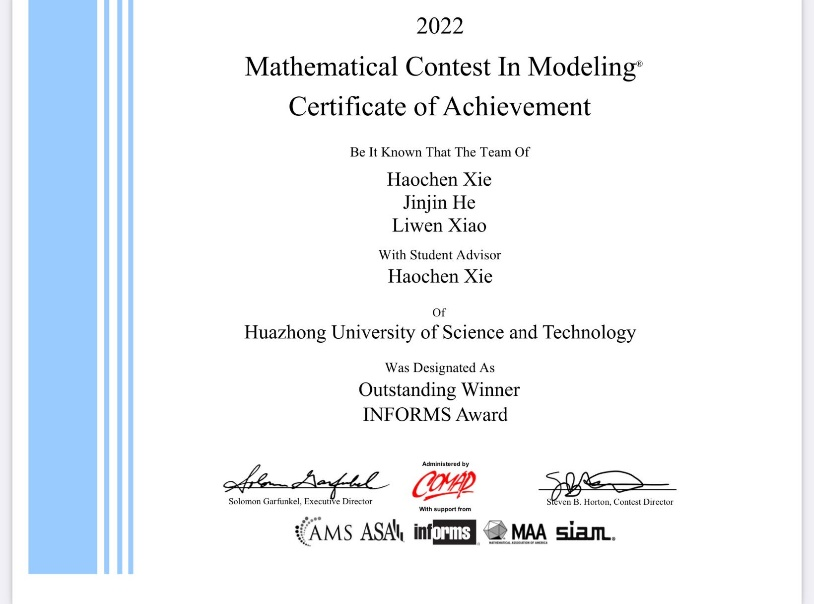窗体顶端
On May 6, 2022, the winners of the 2022 Mathematical Contest In Modeling (MCM/ICM) were announced. The team of senior undergraduates in AIA, members including He Jinjing, Xiao Liwen and Xie Haochen, has won the Outstanding Prize and the INFORMS Award (The Institute for Operations Research and the Management Sciences, International Society for Operations Research and Management Sciences Award). This is the third time that a HUST team has won the Outstanding Prize (the first time was in 2014 and the second time in 2016), and also the second time that HUST has won the INFORMS Award.

MCM/ICM was hosted by the Consortium for Mathematics and Its Application (COMAP) in the U.S. It is a top-notch international mathematical modeling competition and has great influence in the world. The competition attracted 27,205 teams from 22 countries and regions, with more than 81,000 college students participating this year. A total of 44 O(Outstanding) awards, 684 F(Finalist) awards, 1797 M(Meritorious) awards, and 5,803 H(Honorable Mentions) awards were granted to participating teams, and the winning rate of O awards was merely 0.16 percent. In addition, International Association for Operational Research and Management Science re-examined the papers that have won the O prize, and finally selected best papers to confer the INFORMS Award. Only six teams could win this honor every year.

An introduction of the work:
The paper aims at making clear the power curves and power distribution of different cyclists during the cycling race, so as to guide the cyclists to achieve better grades in individual time trials.
Based on that, the team first devised the Muscle Fatigue - Recovery Model and Energy Conservation Model, and combined them to get a Cyclist Power Output Model. Then, the real world road point coordinate information was collected from Google Earth to build the data structure of the road. After that, the team built a Newtonian mechanical model of bicycles based on the cycling routes, and further established the motion equation of cyclists based on Newton's second law. Dynamic programming optimization was defined based on the three models. Moreover, environmental factors such as wind speed, wind direction and ground humidity were also considered in the study of the influence on cyclists' plan execution error. At last, the team revised some parameters (eg. air resistance) in the previous model to simulate team time trials. The results simulated by the team model and algorithm fit well with the real game data, and thus the conclusion can be drawn that their model is instructive for real cycle racing.
Team reflection:
During the four-day competition, we have spent most of the time discussing the problem-solving ideas and methods After a thorough consideration, we settled on the dynamic programming method, which in our view, was the key of winning the prize. After going through a whole process of programming, drawing and paper-writing, it was already 4 am in the morning before submitting the paper. Although very tired, we felt that we had come up with a good solution.
Seeing the results of the competition, everyone was surprised and honored to win another glory for our school and university in an international competition. We will continue to work hard in our own field!

